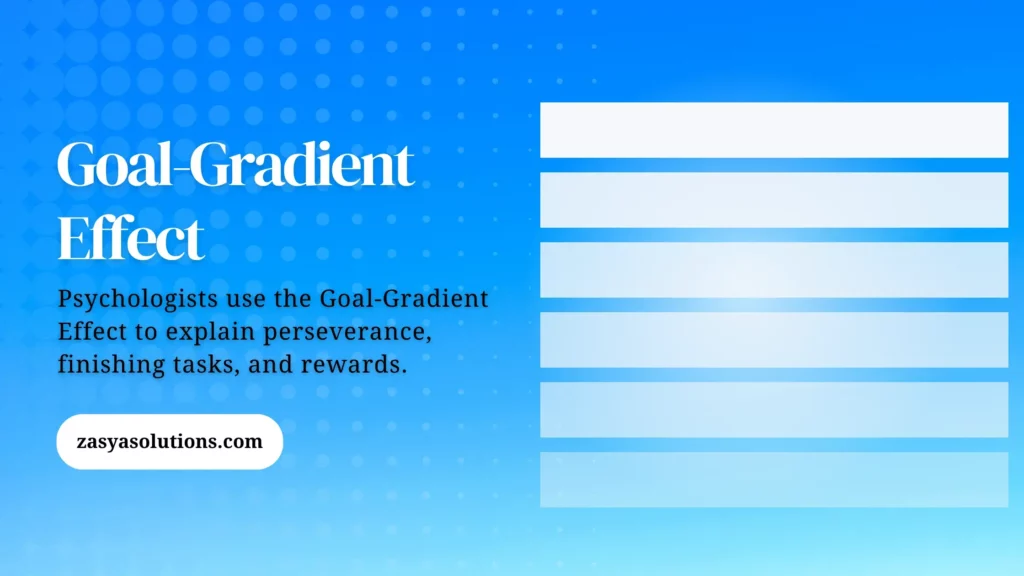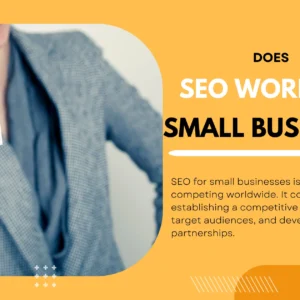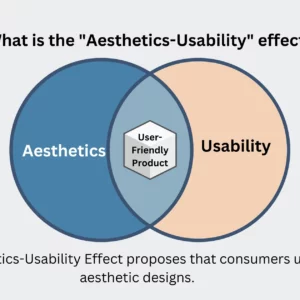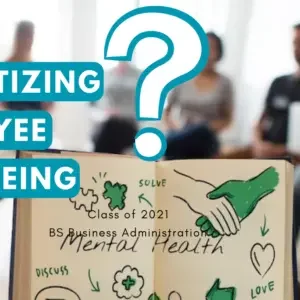The Goal-Gradient Effect is a psychological concept. According to it, people get more motivated when they get closer to a goal, and it affects how we behave. The concept traces its roots to the early 20th century. It was a time when psychologist Clark L. Hull proposed the idea of a “goal gradient” in his drive-reduction theory. The effect gained prominence with the works of behaviorist B.F. Skinner. He explored the impact of reinforcement on goal pursuit.
The idea that being close to a goal makes you more motivated has changed over time. It is now used in many different areas, like Seo and digital marketing company and also for self-help. Psychologists use the Goal-Gradient Effect to explain perseverance, finishing tasks, and rewards. The phenomenon explains how people stay motivated and achieve goals despite their challenges.

Understanding the Psychological Mechanism:
Human behavior is greatly influenced by the expectation of rewards and Pavlovian training. This psychological process links a neutral thing with a result, causing a learned reaction. It is named after Ivan Pavlov’s well-known experiment on dog. When it comes to human conduct, this conditioning can result in the expectation of rewards. It can affect judgment and reinforce particular behaviors.
On the other hand, the brain’s reward system is the neurological underpinning for the goal-gradient effect. When people feel closer to a goal, they become more motivated to achieve it. Dopamine, a neurotransmitter, helps us feel rewarded and motivated to achieve our goals. From a behavioral psychology perspective, understanding these factors is paramount. Psychologists use it to study how stimuli, responses, and reinforcement affect human behavior. This helps with therapy and behavior change.
Examples of the Goal-Gradient Effect:
>> Starbucks Rewards program:
Starbucks Rewards gives users the chance to gain points with every purchase. Customers advance through several membership levels, such Green and Gold, as they add stars. Customers are more driven to make more purchases to meet and keep the Gold level the closer they get to that goal. The perception of being close to the goal (Gold status) serves as a strong motivator.
>> Online courses and learning platforms:
Progress bars are a common feature of online learning systems. It let students see how far along they are in a course. Students are more likely to complete the program if they see progress in the modules. Completing each part feels like progress toward finishing the course. All thanks to the goal-gradient effect.
>> Mobile app onboarding experiences:
When users download a new mobile app, they must complete an onboarding process. This process includes specific stages or activities. To increase user engagement, add a progress tracker or gamified component. This will show users how close they are to finishing the onboarding process. Users who are almost done with onboarding are more likely to use the app often. The goal-gradient effect is used to influence user behavior and encourage people to take actions that move them closer to their goals. It implies a sense of advancement and closeness to the desired result.
Applying the Goal-Gradient Effect in Personal Goals:
To achieve personal goals, prepare strategically and use motivation with the Goal-Gradient Effect. Setting goals is an excellent way to significantly increase your chances of success. The SMART goals framework helps you achieve your objectives. It outlines specific, measurable, achievable, relevant, and time-bound goals. Break large goals into smaller, attainable parts to improve the Goal-Gradient Effect. Use chunking and sub-goals. People try harder and stay motivated as they get closer to a goal. Breaking a goal into smaller milestones helps track progress. Each milestone becomes a marker. This creates a loop that helps people get closer to their goals.
Gamification can help motivate personal growth along with other methods for setting goals. Certain apps use game features to make it more enjoyable to reach personal goals. Applications often include prizes and badges to motivate users and make them feel accomplished. This is known as the Goal-Gradient Effect. In gamified platforms, fitness tracking and goal attainment add a new level to personal growth. Tracking your physical activity and reaching your fitness goals can lead to a healthier life and fulfill your desire to succeed. If you see signs of progress, like walking more or improving exercise results, it boosts the Goal-Gradient Effect. It creates a positive loop of motivation that helps people stay on their personal development journey.
Strategies for Utilizing the Goal-Gradient Effect
The goal-gradient effect is a psychological phenomenon. Individuals tend to increase their efforts as they approach toward a goal. This impact may be used to boost motivation and drive desirable actions. Here are some ideas for maximizing the goal-gradient effect:
A. Combining Intrinsic and Extrinsic Motivation:
To create lasting motivation, connect personal goals to the internal drive for a strong and enduring motivation. This entails building a link between tasks or objectives and the person’s personal beliefs and interests. By stressing the relevant components of an activity, the intrinsic drive may be organically increased. The careful use of extrinsic incentives can play an important role in motivation. It is vital to create incentives that are meaningful to the individual and are consistent with their ideals.
Intermittent incentives can help to boost interest and motivation over time. Be careful not to unintentionally weaken motivation by using external rewards. Creating a sense of autonomy is also critical. When people have the power to make decisions, they feel more motivated to achieve their goals. To understand motivation, think about ideas that encourage short-term engagement and long-term commitment.
B. Designing Effective Progress Indicators:
Breaking down objectives into digestible milestones is an important success tactic. Individuals can enjoy a sense of progress at each milestone. They can reduce goals into smaller, manageable tasks, activating the strong goal-gradient effect. Visualizing success is also important. People can use tools such as progress bars, charts, or graphs to make improvements real and easily understandable. These visual tools serve as frequent reminders of the goal’s path. Furthermore, adding feedback loops is critical for maintaining momentum.
Giving feedback helps people get better by acknowledging their accomplishments. Feedback also helps them improve their tactics. Positive feedback boosts motivation. On the other hand, constructive criticism allows for required modifications. It guarantees a continual and successful pursuit of the final objective. The combination of milestone breakdown, visual representation, and feedback loops gives a dynamic framework. This framework aids in attaining and maintaining success in any project.
C. Personalization and Individual Differences:
Customized goals are crucial for boosting motivation and productivity. To create a personalized plan, consider your interests, strengths, and values. This will help activate the goal-gradient effect. We must use flexible techniques that recognize and adapt to various learning and working styles. You will get more inclusive atmosphere. This atmosphere let you to adapting to each individual’s particular preferences in the achievement of goals. To further help this process, it is critical to identify and drop possible roadblocks. Providing tools and help that are targeted to specific issues creates a more favorable road to goal attainment.
Including customized rewards adds a new element of drive to the equation. Tailoring incentives based on personal preferences is crucial because people are motivated by different things. Some people may be motivated by social recognition, but others may be motivated by physical benefits. By understanding and addressing these differences, we can create personalized plans for success. This leads to a positive and productive work or learning atmosphere.
Future Trends and Developments
Dynamic forces mold the future environment. Three key variables predict its contours: developing technology, evolving psychological theories, and the broadening variety of applications. Emerging technologies are ushering in a paradigm shift in how we live and work. These range from artificial intelligence to biotechnology. The influence of these technologies goes beyond mere convenience. They reshape the basic fabric of civilization. Artificial intelligence, for example, disrupts industries by automating processes and decision-making. It alters work landscapes and provides new possibilities. Motivational psychology theories are evolving in lockstep with technological improvements.
Traditional theories of human behavior are giving way to a more complex understanding. It incorporates parts of neuroscience and behavioral economics. This sophisticated knowledge improves personal development initiatives. It also influences corporate leadership and team relations. The potential applications of these themes are growing beyond the spheres of marketing and personal development.
For example, in healthcare, the confluence of technology and psychology enables more effective patient engagement and adherence. With tailored learning experiences that use insights from changing motivational theories, education is undergoing a change. These improvements have repercussions in governance, urban planning, and environmental sustainability. Here, technology and psychology meet to build systems that are in tune with human desires. The convergence of emerging technologies, evolving psychological theories, and diverse applications shape a future. In which innovation is not confined to a single sector but weaves a tapestry of interconnected possibilities, fostering societal advancement.
Conclusion
As we conclude our trip, keep in mind that harnessing the power of gradual improvement is the key to success. Applying the Goal-Gradient Effect in your life may lead to great results. It can be just as completing each checkpoint increases your urge to go farther.
So, whether you’re pursuing personal or professional objectives, keep up the momentum. Celebrate each stride forward, and before you realize it, you’ll be basking in the radiance of your achievements. Cheers to success, growth, and the incredible road that lies ahead!






